Gochujang sauce is a versatile, spicy-sweet condiment that brings bold, umami-rich Korean flavors to your favorite dishes. Made with gochujang paste, garlic, soy sauce, and a hint of sweetness, this sauce perfectly balances heat and depth. Whether you’re drizzling it over rice bowls, tossing it with noodles, or using it as a marinade, this quick and easy recipe is sure to elevate your meals.
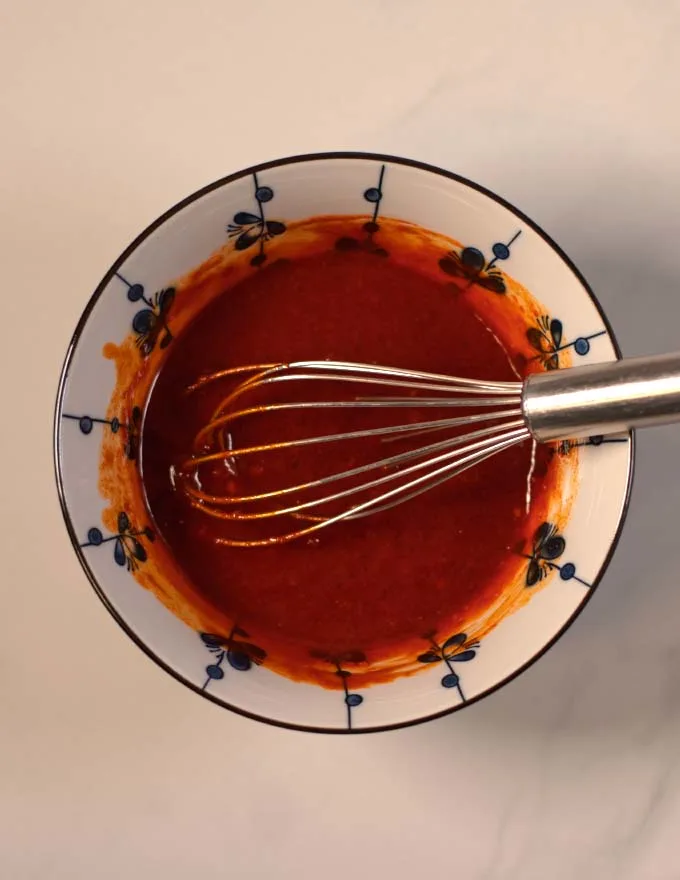
What is Gochujang paste?
Gochujang paste is a traditional Korean fermented chili paste made from red chili powder, glutinous rice, fermented soybeans, and salt.
Known for its bold, complex flavor, it combines a spicy kick with subtle sweetness and a rich, savory depth.
Gochujang is a staple in Korean cuisine, used in dishes like bibimbap, tteokbokki, and marinades for meat, adding a signature heat and umami flavor.
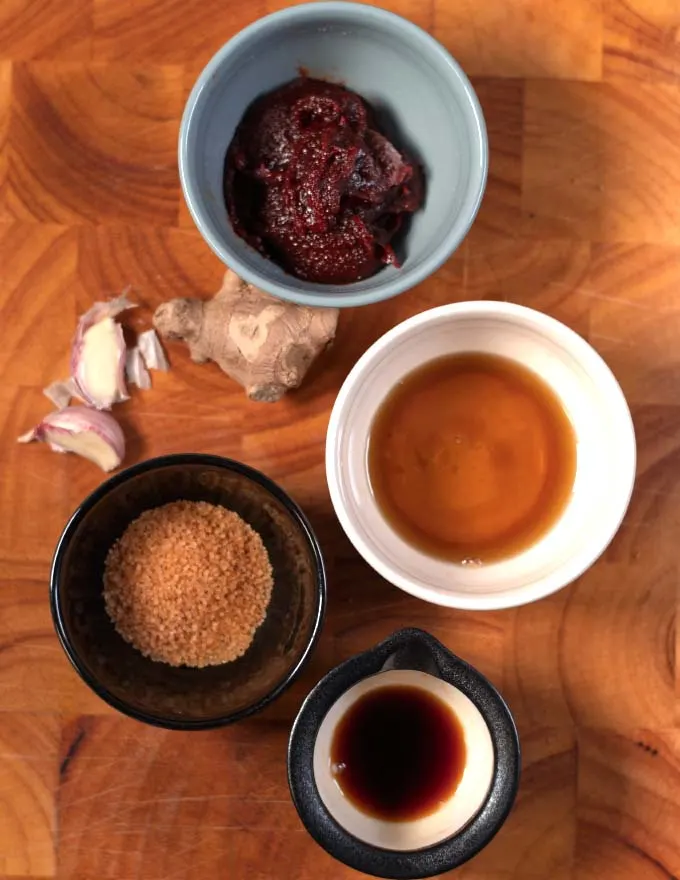
What ingredients go into this Gochujang sauce?
Gochujang paste is the heart of this sauce, offering a unique combination of heat, subtle sweetness, and umami derived from its fermentation process. This deeply flavorful paste, made from red chili peppers, glutinous rice, fermented soybeans, and salt, is what gives the sauce its signature bold character. To balance the fiery spice, brown sugar is incorporated, bringing a mellow sweetness with caramel-like notes that enrich the overall flavor profile and soften the intensity of the gochujang.
Soy sauce contributes another layer of complexity, adding a rich, savory saltiness that enhances the umami depth of the sauce. Fresh garlic, with its sharp, earthy, and pungent flavor, infuses the sauce with boldness, while grated ginger provides a complementary warmth and zesty brightness that harmonizes beautifully with the chili and garlic. Rice vinegar acts as a balancing agent, introducing a light tanginess that cuts through the richness and adds a refreshing, slightly acidic note to the mix.
To finish, sesame oil, with its luxurious nutty aroma and smooth texture, rounds out the sauce. This fragrant oil, pressed from toasted sesame seeds, lends a rich and toasty quality that enhances the overall depth of the flavors. Combined, these ingredients create a versatile and flavorful gochujang sauce that is both bold and well-rounded, perfect for adding a punch of Korean-inspired flair to any dish.
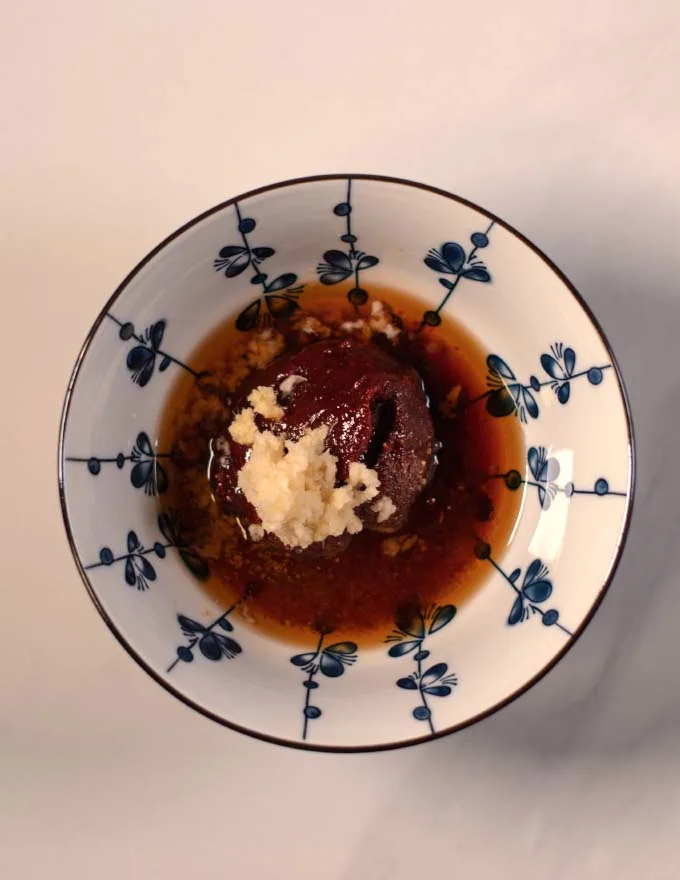
How to make Gochujang sauce from paste?
Prepare by peeling the garlic and ginger.
In a medium-size mixing bowl, combine Gochujang paste with brown sugar, soy sauce, rice vinegar, pressed garlic, and grated ginger. Mix everything togteher to a sauce with a wire whisk.
Depending on the thickness of the Gochujang paste you use, you can add up to 2 tbsp of water to thin the Gochujang sauce.
These simple steps are all you need to do.
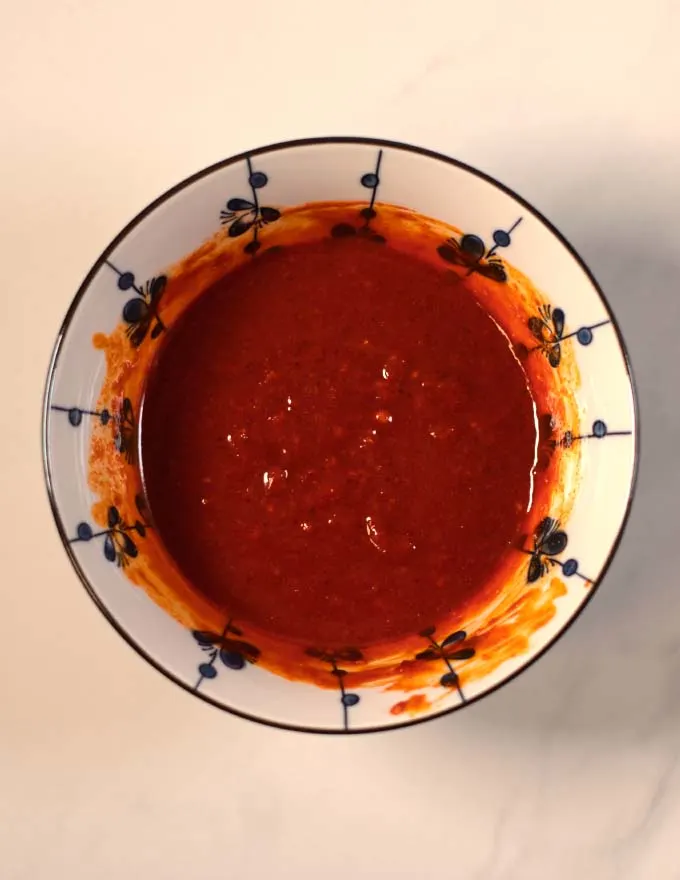
What to serve with Gochujang sauce?
Gochujang sauce is incredibly versatile and pairs beautifully with a wide variety of dishes. It’s an essential companion to rice and grain dishes, such as bibimbap or simple rice bowls topped with vegetables and proteins like chicken, tofu, or beef. The sauce also works wonderfully with noodles, whether tossed with cold soba for a refreshing meal or used as a base for stir-fried noodles packed with vegetables.
Proteins are elevated with a touch of gochujang sauce, from grilled or roasted meats like chicken, pork, or fish to plant-based options like marinated tofu. Vegetables, too, benefit from its bold flavors, making it ideal for tossing with roasted broccoli, zucchini, or carrots. It can be used as a dipping sauce for appetizers such as dumplings, spring rolls, or savory Korean pancakes, and it’s a must-have in traditional Korean dishes like tteokbokki or lettuce wraps.
For soups and stews, gochujang sauce adds a spicy depth to brothy dishes like ramen or hearty stews like kimchi jjigae. Its ability to balance heat, sweetness, and umami also makes it a fantastic addition to fusion dishes, such as Korean-inspired tacos. Whether used as a marinade, dip, or stir-in, gochujang sauce brings a flavorful Korean twist to countless meals.
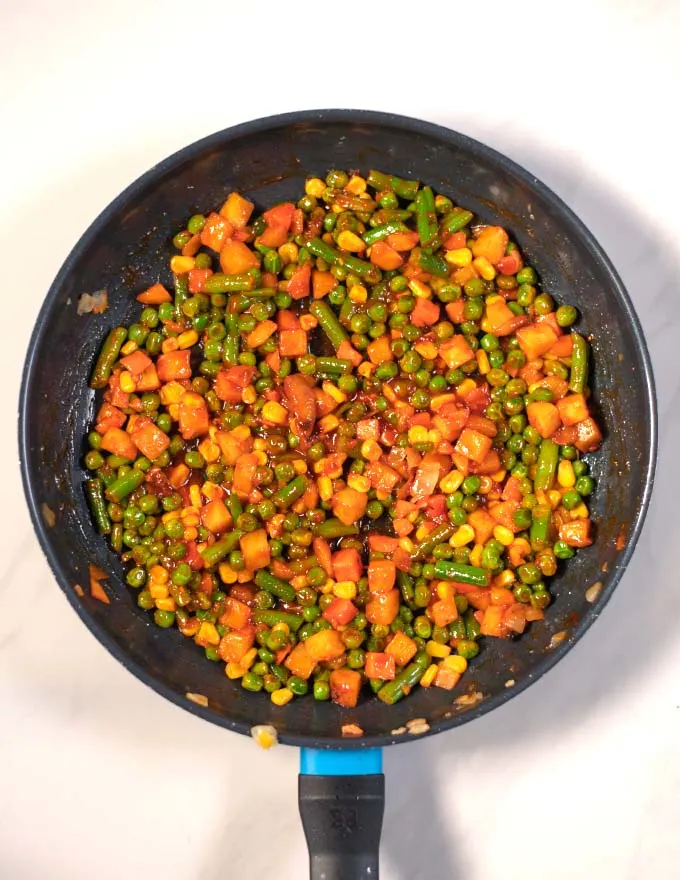
What are popular variations?
Sweeter Variation: Add more brown sugar, honey, or maple syrup for a milder, sweeter flavor, ideal for Korean fried chicken or as a dipping sauce.
Spicier Variation: Increase the heat with red chili flakes, fresh chilies, or a splash of sriracha for those who love extra spice.
Tangy Variation: Enhance the tanginess with additional rice vinegar or a squeeze of lime juice, perfect for salad dressings or grilled veggies.
Creamy Variation: Blend with mayonnaise, sour cream, or Greek yogurt for a rich, mellow sauce that works great on tacos or as a spread.
Sesame-Enhanced Variation: Boost the nutty flavor with extra sesame oil or toasted sesame seeds, ideal for noodles or dipping.
These tweaks allow you to tailor the sauce to different dishes and flavor preferences.
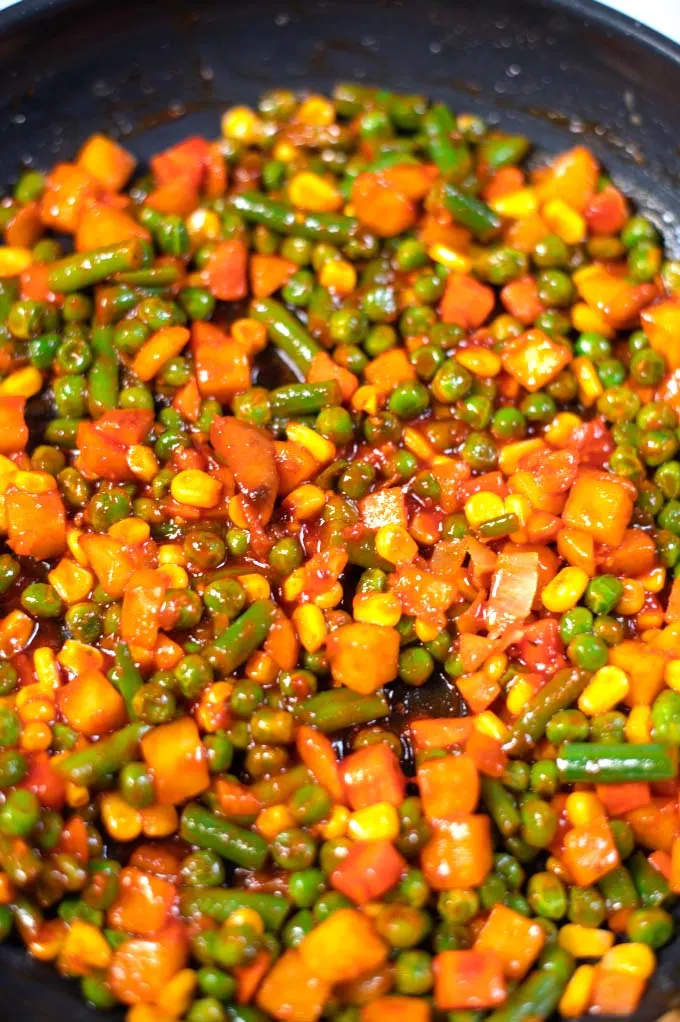
Other sauce recipes to try
- Easy Pad Thai Sauce with Ketchup Recipe
- Fajita Sauce
- Carolina BBQ Sauce
- Quick Diavolo Sauce Recipe [spicy, vegan, easy]
- Best Dijon Mustard Sauce Recipe [creamy without cream]
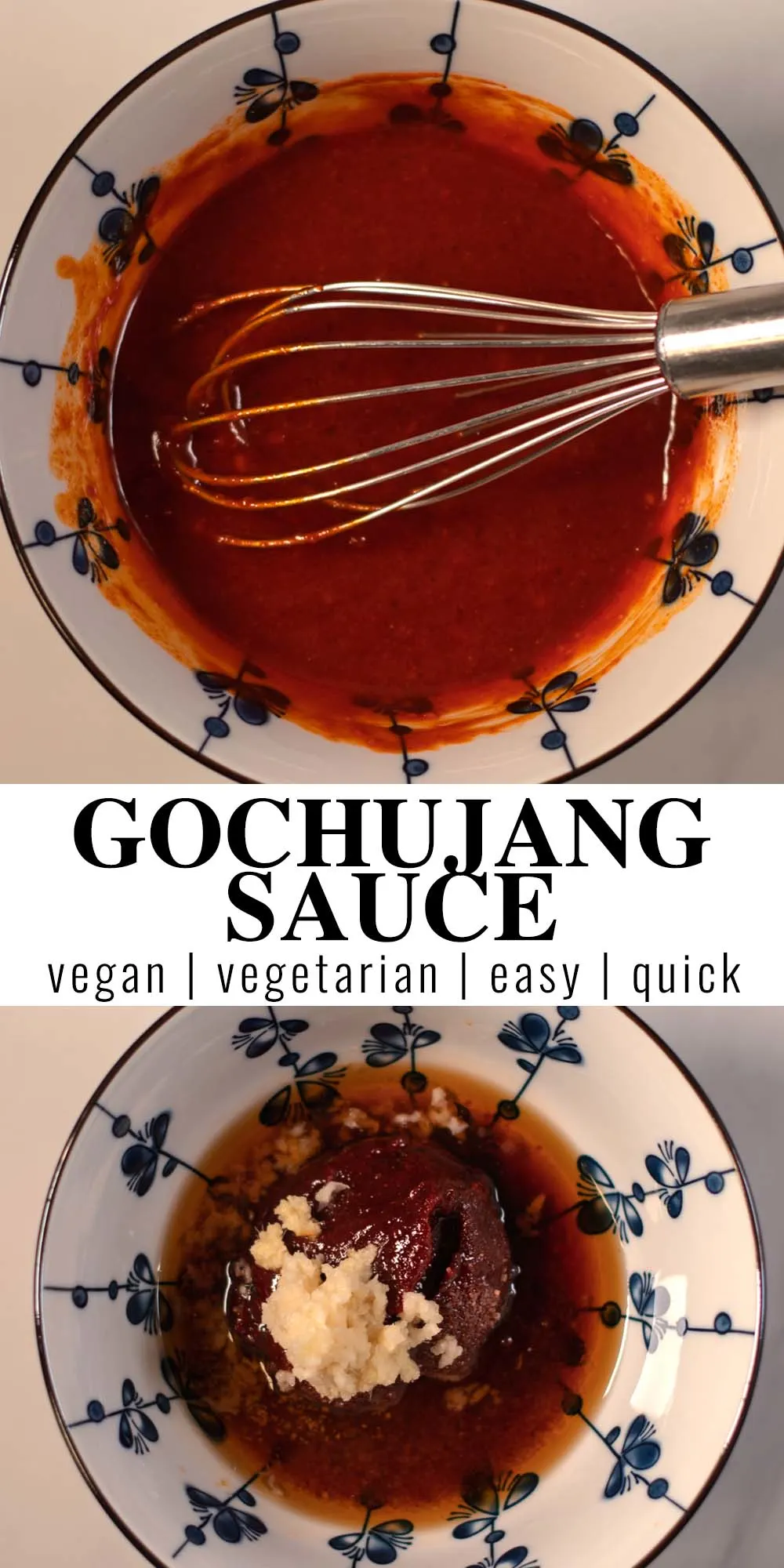
I hope you love this gochujang sauce as much as I do—it’s such a game-changer for adding bold, delicious flavors to almost anything! If you try it, I’d absolutely love to see your creations.
Snap a photo and share it on Instagram or Facebook, and don’t forget to tag me so I can cheer you on!
Also, let me know how it turned out by leaving a comment and a star rating below. Your feedback makes my day and helps others discover this recipe too!
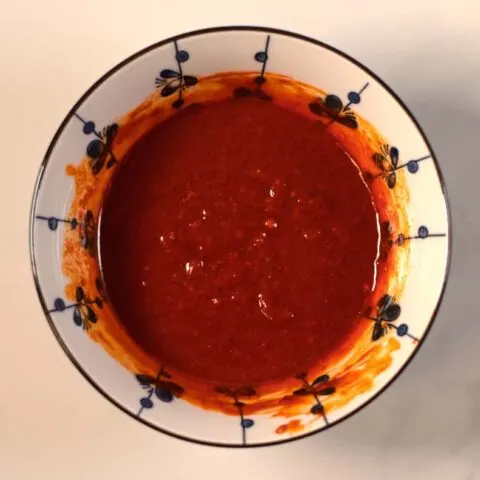
Gochujang Sauce
Gochujang sauce is a versatile, spicy-sweet condiment that brings bold, umami-rich Korean flavors to your favorite dishes. Made with gochujang paste, garlic, soy sauce, and a hint of sweetness, this sauce perfectly balances heat and depth. Whether you're drizzling it over rice bowls, tossing it with noodles, or using it as a marinade, this quick and easy recipe is sure to elevate your meals.
Ingredients
- 3 tbsp Gochujang paste
- 1 tbsp brown sugar
- 1 tbsp soy sauce
- 2 cloves garlic, peeled and pressed
- 1 tbsp rice vinegar
- 2 tbsp water
- 1/2 inch ginger, peeled and grated
- 2 tbsp sesame oil
Instructions
- Prepare by peeling the garlic and ginger.

- In a medium-size mixing bowl, combine Gochujang paste with brown sugar, soy sauce, rice vinegar, pressed garlic, and grated ginger. Mix everything togteher to a sauce with a wire whisk.

- Depending on the thickness of the Gochujang paste you use, you can add up to 2 tbsp of water to thin the Gochujang sauce.

Nutrition Information:
Yield: 4 Serving Size: 1/3 cupAmount Per Serving: Calories: 118Total Fat: 7gSaturated Fat: 1gTrans Fat: 0gUnsaturated Fat: 6gCholesterol: 0mgSodium: 892mgCarbohydrates: 14gFiber: 0gSugar: 10gProtein: 1g